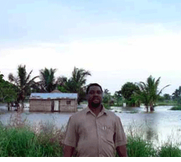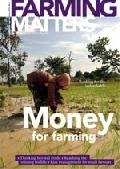Farmers need more than loans to sustain their business. Micro-insurance can help farmers avoid falling into poverty traps because of disasters.
When farmers in, for example, Africa experience a severe drought that kills livestock, and harms family members, they are often left with no livestock and no yield. In the most extreme cases this may trigger (international) aid programmes. However, the processes of risk and loss assessment are often cumbersome and bureaucratic, involving a lot of paperwork and data processing. It can take many months, sometimes more than a year, before any compensation makes its way to the farmers to enable them to rebuild their lives. In many cases, it arrives too late.
In 2006 the World Food Program piloted a pioneering insurance scheme in Ethiopia to enable farmers to insure themselves against heavy drought. The scheme takes the most severe drought years of the past as a baseline. If indicators show a historically extreme drought is coming, money is immediately paid out, before the crisis arises and there is a shortfall in yields. This is not a difficult assessment to make; it just involves looking at weather data. In Ethiopia the rains between March and October are the trigger period. If there is no rain in early in the year, then it is clear that there will be not enough yields in autumn. This triggers the insurance mechanism, before nature takes its toll. Money flows immediately, allowing farmers to cope much better with the situation – before the drought creates tremendous problems. The money allows them to buy food or grains; families can survive, livestock can be better protected. This particular scheme in Ethiopia covered a few hundred thousand farmers, the sum insured was US$ 7 million. This is the advantage of micro-insurance in a nutshell. Normally, when disasters occur, money may flow, but only after a long and complex assessment. Microinsurance, in this case index insurance (insurance based on an external indicator, like weather patterns, which triggers a payment to all insured clients), can work even before a disaster strikes.
Obstacles and promising concepts
In many countries in South America, Asia and Africa, micro-insurance products are difficult to establish for want of suitable or reliable data. It is also difficult to win people’s trust and understanding for insurance schemes when they have not previously had experience with financial services. It is very difficult to explain that their premium payments are not savings.
Thankfully, there are now plans to remove such obstacles. Apart from the programme in Ethiopia, in recent years a number of new micro-insurance solutions have been devised to cover the risks of poor crop and livestock farmers in Asia and Africa.
India, for example, has micro-insurance programmes under which farmers can insure their livestock. This provides a way of mitigating losses caused by catastrophic events. In Mongolia, where livestock farming is of major importance, livestock farmers have been able to cover themselves against adverse weather conditions since 2006. Premiums are low, and the scheme has been subsidised by the state and the World Bank. The scheme is doing fine and developing. In the same way, tobacco and peanut farmers in Malawi have been able to insure themselves against lack of rainfall since 2006. Microloans for failed harvests are insured in this way, so that people can cope better when there is a drought.
These examples are early promising solutions. However, it is vitally important that the scope of these insurance products extends over several years (which implies building long term relationships), that the products are tailored to the needs of the people, and that there is a sufficiently broad geographical spread, so that the micro-insurance providers can deal with the costs and financial risks of such programmes.
Micro-insurance and climate change
Micro-insurance is especially relevant when considering the effects of climate change. More irregular precipitation, more flash floods, more extreme droughts; all increase risks in the agricultural sector and affect farmers, particularly in developing the number of people on the world’s poorest continent affeted by drought could soon exceed the 200 million mark.
Micro-insurance is but one adaptation strategy, and index products can provide an appropriate approach for working with poor communities. In the long term it could even open up future markets to the insurance industry, as well as offering farmers security and new opportunities.
Text and photo: Thomas Loster
Thomas Loster (tloster@munichre-foundation.org) is an insurance expert specialising in climate change and natural disaster. He is a geographer and chairman of the Munich Re Foundation.
More Information
News and information about micro-insurance can be found online at www.microinsurancenetwork.org and also at www.microinsurance.org. An international conference on micro-insurance, hosted by the Munich Re Foundation and the Micro-insurance Network, will take place in Manila, Philippines, from 9 to 11 November 2010.


